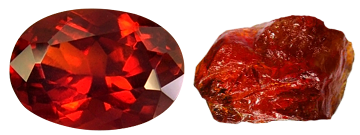 Photo of Hessonite in Processed & Rough Form
Photo of Hessonite in Processed & Rough Form
Hessonite is a mineral with a hardness of 8 out of 10 on the Mohs scale of mineral hardness [?]. These Cubicly structured gems are made of calcium aluminum silicate, their full chemical compound being Ca3Al2(SiO4)3.
Hessonite is the brown-orange variety of Grossular, a nesosilicate in the Garnet group, with an isometric crystal system.
It appears with dodecahedral or trapezohedral crystals, cinnamon-brown to orange because of its iron content. Its color matches that of the oil of cinnamon. It also appears as golden-yellow, yellow-brown, or reddish-brown.
It is very hard, heavy, fragile, has no cleavage. It is transparent to translucent with vitreous luster, infusible, and insoluble. Under artificial light it becomes fiery red, and contains small inclusions that appear as rounded oily streaks or swirls known as treacle. Recent examinations show that this is the result of a mosaic structure caused by intergrown hessonite grains.
Scapolite inclusions have been reported in massive hessonite from Maligawila (Sri Lanka), and also from Lelatema (Tanzania). Lamellar growth structures in Mexican hessonite produce iridescent colours similar to that reported for Mexican andradite.
Yellow-orange hessonite shows no spectrum in lighter tones; however, with increasing colour saturation, absorption towards the blue end of the spectrum becomes more intense.
Hessonite is a mineral typical of regional and contact metamorphism of calcareous rocks, associated with calcite, wollastonite, vesuvianite, diopside, and scapolite.
Superb, clear hessonite crystals are found in the gem-bearing sands of Sri Lanka, India, in the rodingite bodies of California (Ramona), the western Alps (Val d'Ala, Val d'Aosta and Valle del Sangone, in Val della Gava, Liguria-all in Italy), at Asbestos (Canada), Mali, Namibia, Tanzania, Mexico, Brazil, and Maharitra (Madagascar). Lighter oranges, yellows and peachy-coloured stones occur in deposits in Alberta and Quebec (Canada).
It is also called "cinnamon stone," "essonite," "cinnamite," "kaneelstein" (German)
It can be confused with spessartite and hyacinth.
Some misnomers for hessonite include: California hyacinth - hessonite from California (USA); Ceylon hyacinth - hessonite garnet from Sri Lanka; Oriental hyacinth; false hyacinth.
The specific gravity [?] for Hessonite is 3.65, it's refractive index [?] is 1.73-1.75, and it's double refraction [?] is None.
History
Hessonite derives its name from the Greek "hesson," meaning "less" or "inferior," referring to its lower density and hardness compared to other varieties of garnet.
Industrial Usages
Hessonite is often lower-priced than the higher-quality and more popular spessartite garnet, and thus can often be difficult to find on the market.






